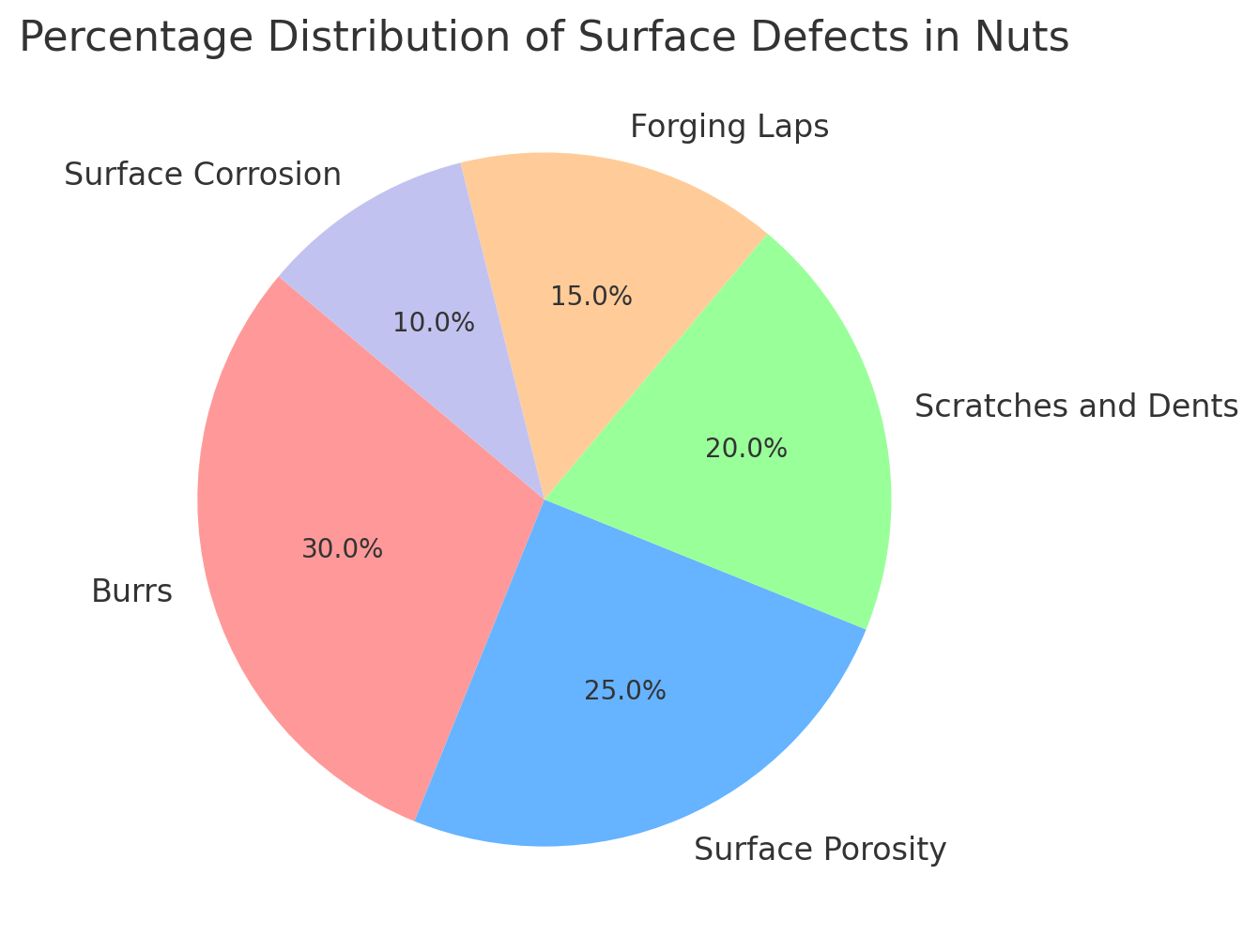Superficial Defects of Nuts UNI EN ISO 6157-2: Technical Analysis and Impact on Mechanical Components
Introduction
Nuts, as critical fastening elements, must meet strict quality standards to ensure safety and reliability in mechanical applications. The UNI EN ISO 6157-2 standard specifies the requirements for surface defects of nuts produced by cold or hot forming and covers strength classes from 5.6 to 12.9. These defects can affect both the aesthetics and functionality of nuts, compromising the integrity of threaded joints and, consequently, the overall reliability of the assembly. This document explores the main surface defects that can occur in nuts according to UNI EN ISO 6157-2, analyzing their causes, effects, and inspection methods to ensure compliance with standards.
Types of Surface Defects
Surface defects in nuts can be categorized into different groups, each with specific characteristics that may affect the nut’s performance. Below are the main types of defects:
Burrs
- Description: Small ridges or protrusions forming on the edges of the thread or the bearing surface.
- Causes: Typically caused by inaccurate stamping or threading processes.
- Effects: Can interfere with threaded coupling, hinder proper tightening, and damage the thread.
Surface Porosity
- Description: Small cavities or bubbles on the surface of the nut.
- Causes: Often result from gas inclusions during casting or an imperfect stamping process.
- Effects: Porosity can compromise the mechanical strength of the nut and its sealing capability.
Scratches and Dents
- Description: Wear marks or small damages formed on the surface during handling or transportation.
- Causes: Incorrect handling or contact with hard surfaces during transport.
- Effects: May reduce corrosion resistance and negatively impact the nut’s aesthetics.
Stamping Craters
- Description: Small depressions or indentations on the nut’s surface.
- Causes: Defects in the stamping process due to inadequate materials or equipment.
- Effects: These craters can weaken the nut’s structure and compromise its load capacity.
Surface Corrosion
- Description: Oxidation or rust formation on the nut's surface.
- Causes: Exposure to moisture or corrosive substances during storage or processing.
- Effects: Corrosion compromises the nut’s durability and may negatively impact tightening.
UNI EN ISO 6157-2 Standard and Compliance Requirements
The UNI EN ISO 6157-2 standard establishes the acceptable limits for surface defects in nuts, ensuring that products meet high-quality standards. The table below summarizes the compliance requirements for each defect type:
| Type of Defect | Acceptable Limits for Strength Classes 5.6 - 12.9 |
|---|---|
| Burrs | Must not interfere with assembly or tightening |
| Surface Porosity | Admissible if it does not compromise strength |
| Scratches and Dents | Admissible if not in critical areas |
| Forging Laps | Must be minimized; not allowed in critical areas |
| Surface Corrosion | Not allowed |
Analysis and Graphs
Distribution of Surface Defects
The following graph illustrates the percentage distribution of different surface defects found in nuts produced according to the UNI EN ISO 6157-2 standard.
This graph highlights the occurrence of the most common defects, such as burrs, surface porosity, and scratches, providing a clear overview of the areas requiring improvement in the production process.

Inspection Methods
To ensure that nuts comply with the standards set by UNI EN ISO 6157-2, various inspection techniques are used:
Visual Inspection
- Description: Basic method for identifying visible surface defects with the naked eye or optical tools.
- Applications: Mainly used to detect burrs, scratches, and dents.
Optical Microscopy
- Description: Used for a detailed analysis of defects such as porosity and stamping craters.
- Applications: Ideal for inspecting microscopic surface defects.
Non-Destructive Testing (NDT)
- Description: Techniques such as radiography or ultrasonic analysis to detect internal or hidden defects.
- Applications: Particularly useful for detecting internal defects that may not be visible on the surface.
Impact of Surface Defects on Nut Strength
Surface defects can significantly impact the strength and reliability of nuts. Defects like porosity and stamping craters can reduce the nut’s load capacity, while scratches and corrosion can accelerate deterioration, compromising assembly safety. Therefore, it is essential to identify and correct these defects to ensure that nuts maintain their mechanical performance over time.
Commercial Conclusion
Effectively managing surface defects in nuts is essential to ensuring the quality and reliability of finished products. Companies that invest in advanced quality control technologies, personnel training, and optimization of production processes can significantly reduce the occurrence of these defects, improving the final product’s quality and customer satisfaction.
In a highly competitive market, the ability to supply nuts that comply with the UNI EN ISO 6157-2 standard is a key differentiator that can help build and maintain long-term customer relationships. Companies that adopt effective preventive measures not only reduce costs associated with production defects but also position themselves as high-quality suppliers capable of meeting the demands of an increasingly demanding market.



